April 7, 2015 5 Reasons You Need an Air Compressor
Here are 5 reasons that you need an air compressor, whether you are a beginning or seasoned DIY-er.
You may never want to use hand tools ever again! And we will also discuss how to determine what air compressor will best suit your needs.
Number 5: If you have any interest in carpentry, crafts or building things, there is nothing like a nail gun to speed things along. And to use a nail gun, you need an air compressor, if you don’t want to spend a lot of money. Battery-operated nailers cost between $200 and $500, compared to just $50-$300 for the pneumatic nailers that are used with air compressors. An added benefit is that pneumatic nailers are lighter and easier to maneuver, and air pressure lasts much longer than a battery charge. Using an air compressor is just a win/win situation for everyone!
Number 4: It makes spray-painting a breeze. With an air compressor powering the spray gun you will be painting furniture, cabinets and smaller fine painting projects in no time at all, just like a pro! There is nothing wrong painting with a brush, especially when you have time on my hands.
But when you don’t, or for fine painting work such as kitchen cabinetry, you need a sprayer to achieve the beautiful, smooth results you will almost certainly be looking for. An air compressor and a sprayer will give you just that. In fact, your whole kitchen could look like new, and for thousands less than either purchasing new cabinets or hiring someone to paint them for you.
Number 3: DIY Auto Repairs. Have secret fantasies of not having to pay your mechanic’s large bill, and doing your own auto repairs? Well, quite often smaller jobs, such as changing out a fuel filter, performing a tune-up or installing a new PCV valve, are very manageable for the average car owner who has received some instruction (for instance, check out our popular See Jane Drill video: “How to Easily Do a Tune-Up On Your Own Car”.)
However, the tricky part for the average person is that it can be difficult to remove bolts that are in tight spaces or where things have rusted…you could be struggling for hours with a regular ratchet and socket set on one of these bolts. But alas, if you use an air ratchet tool attached to an air compressor, you will get that bolt off in seconds! An air compressor really makes many auto repairs entirely doable by just about anyone.
Number 2: Versatility! You can’t beat the versatility and cost-effectiveness of an air compressor. In addition to the uses listed above, there are many other air tools that can be used with an air compressor, and countless jobs around the house that your air compressor will help you accomplish. Need to clean up the sawdust that is all over your garage floor? Get out your air blower tool. Want to hand down a bike from an older child to a younger child, but you want to change the color? Get out your paint sprayer. Need to upgrade the look of a room with new baseboards or crown moldings? An air finish nailer will help you complete the job in a snap. And if that weren’t enough, air tools are much more durable and long-lasting than battery-operated or corded tools because they have less moving parts…there is just one motor powering everything, and that is the motor in the air compressor.
Number 1: It’s cool! An air compressor is just a cool tool. Sure, it takes a bit of effort to learn how to use the air compressor, what the gauges mean, and how to set up your line, but once you know, it’s all clear sailing from there. And guess what? We will show you every step of the way how to get your air compressor and your hose line all set up so that you are ready to start using your tools!
Have we convinced you yet? Well, if so, here is our handy “See Jane Drill Air Compressor Buying Checklist“.
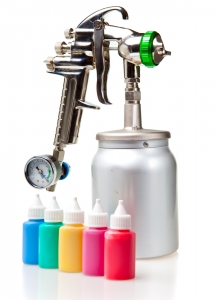 Think about your needs first and consider the following:
Think about your needs first and consider the following:
Space
If you are living in an apartment or a small, tight space with little storage room available, you’ll probably be limited to a smaller unit. Consider a pancake compressor, which could be all you need. Its diminutive dimensions are ideal if space is limited, and it can easily be stored in a closet or on a shelf. Keep in mind, however, that these petite compressors are limited to doing light-duty jobs. Don’t expect it to perform beyond its means, for instance you’re not going to be doing auto repair with one of these units. If you have a home with a garage or workshop space, you most likely will be able to accommodate a much larger portable air compressor, and the size you choose will be based upon what types of projects you will doing, and your budget.
Tank Size
The size of the compressor tank, generally calculated in gallons, should be chosen by the overall type of usage. If the usage will be in short rapid spurts, such as when using a brad nailer, then a small tank size can be used. If the compressor is to bear long periods of usage, such as spray painting, a larger tank size is vital.
Power Source
Air compressors run on either electricity or gasoline. Electric compressors normally operate on standard household current, between 110-120V. Since electric compressors don’t discharge fumes, they are a superior choice for indoor use. Gas-powered air compressors are ideal for working outdoors. These units are best suited for situations when locating a reliable power source may be difficult. In addition, their mobility is a huge asset on most outdoor job sites.
Oil-Lubricated vs. Oil-Free
Oil-lubricated compressors need oil to run. The oil lubricates the moving parts, which aids in preventing wear. These units tend to be heavier than the comparable oil-free models. Oil-free compressors, as their name suggests, operate without the use of oil, and because there is no need for oil, these types of compressors are much smaller and lighter than oil-lubricated compressors. For this reason they’re a popular choice for many homeowners, who value their ease of operation and mobility.
Air Demand and Tool Practices
The projects you will be working on and the tools you plan on using will help determine the size and style of air compressor you’ll need. If you’re going to be mostly using the compressor as a fill tool to inflate car and bicycle tires, inflatable sporting equipment, an air mattress for an occasional visiting guest and so on, than a small unit is probably all you’ll need. If, on the other hand, you’re an avid DIYer who is often involved in home projects requiring a variety of air tools, you will need an air compressor with enough capacity to efficiently operate the tools you are planning to use. Some air tools require much more air than others. For your convenience, refer to the glossary and quick guide below to help you choose the best air compressor for you.
Breaking the Code – A Glossary of Air Compressor Terms
PSI: Pounds per square Inch. This is essentially the measurement of air pressure that is delivered by the compressor. While important to know, the PSI measurement of the air compressor that you choose is actually less important than the CFM (see below).
HP or Horsepower: Horsepower is the measurement of the power of a piece of machinery, such as the motor in a compressor. Compressor motors generally range from 1.5 HP to 6.5 HP. Generally, the higher horsepower motors produce greater psi (pounds per square inch) and are adept at carrying a heavier capacity.
CFM: CFM stands for Cubic Feet Per Minute, or the amount of air a compressor delivers, measured in cubic feet per minute. Note that the CFM a compressor delivers changes, depending upon the psi (pounds per square inch). Most air tools have specific requirements for volume and pressure. These requirements must be met for the tool to function properly. When choosing a compressor, consider the tools you want it to operate. Select the tool you are planning to use that requires the highest CFM, and add a small amount to that number for a margin of safety. For example, if a tool requires 3 CFM at 90 psi, select a compressor that delivers at least 4.5 CFM at 90 psi. This will ensure that the air compressor you purchase can provide the correct amount of air for the tools you are planning to use to function properly.
SCFM: Standard Cubic Feet per Minute, or SCFM. SCFM is the CFM of the air compressor if all conditions were “standard”, which is almost never the case. I thought it was worth mentioning though, in case you see this acronym on an air compressor. Actual CFM almost always varies from the standard, depending upon changes in conditions.
Some Popular Air Tools and Their Average CFM Requirements (at 90 PSI)
For your convenience, we have listed some of the more popular air tools used by DIY-ers, and their average CFM requirements:
- Brad Nailer .03 CFM
- Chisel/Hammer 3-11 CFM
- Drill, Reversible or Straight-Line 3-6 CFM
- Dual Sander 11-13 CFM
- Framing Nailer 2.2 CFM
- Impact Wrench – 3/8″ 2.5-3.5 CFM
- Impact Wrench – 1/2″ 4-5 CFM
- Orbital Sander 6-9 CFM
- Ratchet – 1/4″ 2.5-3.5 CFM
- Ratchet – 3/8″ 4-5.5 CFM
So, now that you know what air compressor to buy, what about how to use it? Fortunately, we have put together an easy-to-follow, step-by-step video guide on how to not only use an air compressor, but exactly how to set it up, including how to set up the line. You will be ready to use your new air compressor in no time at all, and will be astonished at how useful air tools can be around the house. I don’t even know how I lived without mine! Remember, if I can do it, you can do it!
Related Video: Air Compressor Overview and Usage – A Beginner’s Guide
by See Jane Drill, Copyright 2015, All Rights Reserved

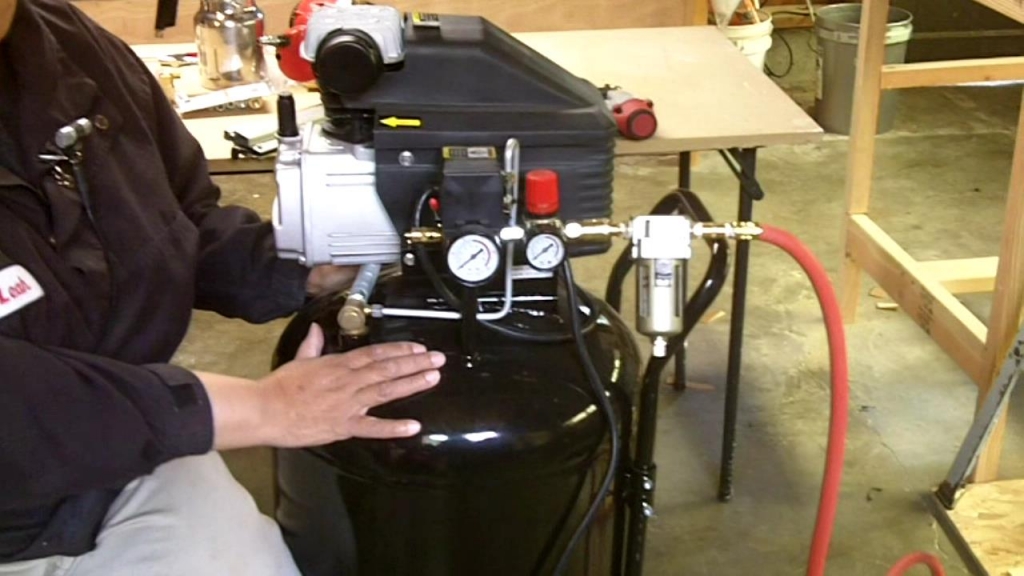
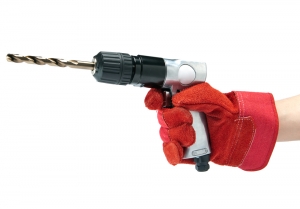
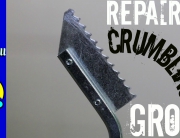

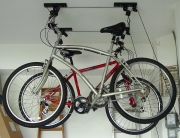



Really useful tips.
thanks!
Air compressor work wonders to some DIY home projects. I normally use it to blow away some dirt or as a cleaning tool. Really effective when used properly
Thanks usefull tips. I have used air compressor for 3 years and it still work well like new one.
You’re welcome, James, glad you liked our vid!
I often have problems with the tires, so I think the car is also an important reason for you to buy a portable air compressor
Great website and videos. Very informative for someone like me, without much experience using compressors.
I was wondering if you could answer a question for me.
I did sime research and bought a compressor that says it delivers 6.5 cfm at 90 psi, so i would have more than the required 4cfm required to run a die grinder.
The compressor only has a five gallon tank.
When i run the die grinder, i expected to watch the tank pressure drop untill the compressor kicked in, then expected the compresser to be able to maintain at least a tank/tool pressure of 90 psi. The compresser kicks in as its supposed to at 110 psi, but with the die grinder running the tank pressure drops below 50psi before i stop the tool and let the pressure build back up to usable.
My question is: could this be something wrong with my new compresser so its not producing its rated cfm,
Or being a newbie to the world of air compressors is there sinething im overlooking.
And is there any easy way to easily measure how many cfm a compresser is actually producing?
Hi Brian, Here is what I believe the problem is. To run a tool, you have to take into consideration, not only the cfm, but also the psi and the tank size. Yes, your compressor is rated for the correct cfm. But that just means that it can deliver the right amount of airflow to operate the tool. The problem is that a 5-gallon tank is very small, and just won’t produce enough air to operate the tool for any length of time before the pressure drops and you have to wait for it to build back up again. Think about an auto body shop, and the enormous air compressors that they have to have to run a paint sprayer for a continuous period of time.
Can you power wash driveways is it strong enough
No
Okay, I new to this but I work on the car a lot and I really want to paint it myself! I have found a few spray guns that are around $75 that I think will do the job. but what else I don’t want to spend a lot of money because I will only be spraying a few cars but I do know that I will need an air compressor. but what kind and size? and is there anything else I will need? thanks
Air compressors can be surprisingly versatile and it is great that the article brings that up. After all, not only can they be used with a variety of tools but, if you really need to, you can use them for cleaning to. Of course, you want to make sure that that you properly take of your air compressor as well so that you don’t have to worry about getting it repaired later.
These are some very good reasons that shows how important an Air Compressor is.
Wow, I had no idea that air compressors could be used for so many things! I have been needing to paint a few things in my home, but I was thinking I might need to do it with a brush. But I was definitely worried about how much time it would take. It sounds like with an air compressor it would be much easier to get it all done quickly. I will be sure to look into getting one for my project. Thanks for the great post!